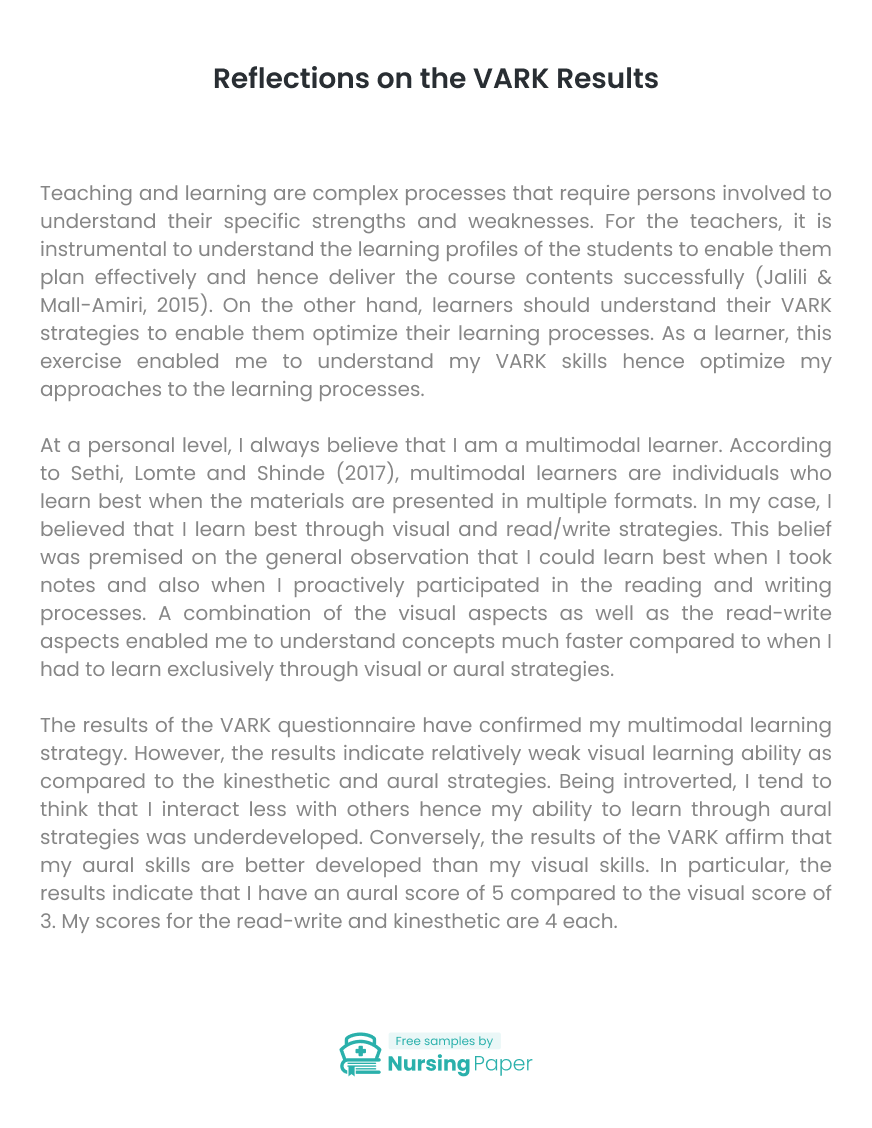
Reflections on the VARK Results
The Body
Teaching and learning are complex processes that require persons involved to understand their specific strengths and weaknesses. For the teachers, it is instrumental to understand the learning profiles of the students to enable them plan effectively and hence deliver the course contents successfully (Jalili & Mall-Amiri, 2015). On the other hand, learners should understand their VARK strategies to enable them optimize their learning processes. As a learner, this exercise enabled me to understand my VARK skills hence optimize my approaches to the learning processes.
At a personal level, I always believe that I am a multimodal learner. According to Sethi, Lomte and Shinde (2017), multimodal learners are individuals who learn best when the materials are presented in multiple formats. In my case, I believed that I learn best through visual and read/write strategies. This belief was premised on the general observation that I could learn best when I took notes and also when I proactively participated in the reading and writing processes. A combination of the visual aspects as well as the read-write aspects enabled me to understand concepts much faster compared to when I had to learn exclusively through visual or aural strategies.


The results of the VARK questionnaire have confirmed my multimodal learning strategy. However, the results indicate relatively weak visual learning ability as compared to the kinesthetic and aural strategies. Being introverted, I tend to think that I interact less with others hence my ability to learn through aural strategies was underdeveloped. Conversely, the results of the VARK affirm that my aural skills are better developed than my visual skills. In particular, the results indicate that I have an aural score of 5 compared to the visual score of 3. My scores for the read-write and kinesthetic are 4 each. Generally, the results indicate that I am a balanced learner who can apply any of the strategies to effectively learn about the various concepts. However, it also affirms that combining different strategies would work best for me.
While the results are plausible, the learning strategies adopted at any given time are influenced by the contents to be studied. For instance, one might prefer visual strategies to aural strategies when it comes to learning complex concepts that can be summarized into flowcharts. On the other hand, aural strategies could be employed to learn less complex concepts such as direction (Condon & Ruth-Sahd, 2013). As an example, a multimodal aural learner would not require a map when visiting a place with distinct streets. In such cases, aural explanation of the directions would be satisfactory.
Within the classroom environments, however, multimodal learners might prefer visual strategies to learn concepts. Conventionally, visual strategies help to advance one’s photographic memory and hence enable them to remember learnt concepts. As such, multimodal visual learners learn best from lecturers who use visual aids and simulations to ensure that students effectively learn the various concepts (Kharb, 2013). Also, graphical summaries, pictures, slides and videos are their preferred learning tools for exams. In this light, the VARK results underestimated the visual learning abilities.

As an aural learner, however, there are a number of personal preferences that are accurately captured by the VARK results. Firstly, aural learners consistently attend lectures because they believe that listening attentively to the lecturer is vital. Aural learners prefer taking part in group discussions with my selected peers. For introverted aural learners, however, it might be challenging to interact with new students (Condon & Ruth-Sahd, 2013). During the discussions, aural learners can openly discuss new ideas with colleagues and engage in jokes which can help them to memorize the concepts learnt during the discussions.
1. Condon, M., & Ruth-Sahd, L. (2013). Responding to introverted and shy students: Best practice guidelines for educators and advisors. Open Journal Of Nursing, 03(07), 503-515. doi: 10.4236/ojn.2013.37069
2. Jalili, S., & Mall-Amiri, B. (2015). The Difference between Extrovert and Introvert EFL Teachers’ Classroom Management. Theory And Practice In Language Studies, 5(4), 826. doi: 10.17507/tpls.0504.19
3. Kharb, P. (2013). The Learning Styles and the Preferred Teaching–Learning Strategies of First Year Medical Students. Journal Of Clinical And Diagnostic Research. doi: 10.7860/jcdr/2013/5809.3090
4. Sethi, M., Lomte, S., & Shinde, U. (2017). Multimodal Approach to Identify Learning Strategies of Visual and Verbal Learners. International Journal Of Emerging Technologies In Learning (Ijet), 12(10), 76-87. doi: 10.3991/ijet.v12i10.6935



The download will start shortly.

The download will start shortly.
 Subject:
Nursing
Subject:
Nursing  Number of pages: 4
Number of pages: 4  Subject:
Nursing
Subject:
Nursing  Number of pages: 2
Number of pages: 2  Subject:
Health and Social Care
Subject:
Health and Social Care  Number of pages: 5
Number of pages: 5  Subject:
Nursing
Subject:
Nursing  Number of pages: 4
Number of pages: 4  Subject:
Medicine
Subject:
Medicine  Number of pages: 13
Number of pages: 13  Subject:
Nursing
Subject:
Nursing  Number of pages: 5
Number of pages: 5  Subject:
Medicine
Subject:
Medicine  Number of pages: 7
Number of pages: 7  Subject:
Medicine
Subject:
Medicine  Number of pages: 2
Number of pages: 2  Subject:
Health and Social Care
Subject:
Health and Social Care  Number of pages: 5
Number of pages: 5  Subject:
Medicine
Subject:
Medicine  Number of pages: 7
Number of pages: 7  Subject:
Health and Social Care
Subject:
Health and Social Care  Number of pages: 1
Number of pages: 1  Subject:
Nursing
Subject:
Nursing  Number of pages: 8
Number of pages: 8  Subject:
Health and Social Care
Subject:
Health and Social Care  Number of pages: 5
Number of pages: 5  Subject:
Nursing
Subject:
Nursing  Number of pages: 2
Number of pages: 2  Subject:
Medicine
Subject:
Medicine  Number of pages: 3
Number of pages: 3 
